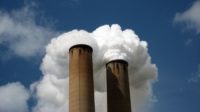Government
EPA Publishes Final Rule on Chemical Plant Air Pollution

U.S. EPA Administrator Michael Regan toured communities impacted by air pollution in 2021.
Photo by Eric Vance/EPA
The U.S. Environmental Protection Agency aims to reduce air emissions of certain cancer-causing pollutants by nearly 80% with a final rule announced April 9. More than 200 existing chemical plants and any others built going forward are expected to have to comply.
The rule requires fenceline monitoring at plants with processes and equipment that produce ethylene oxide and chloroprene, as well as other hazardous pollutants such as benzene, ethylene dichloride and vinyl chloride, used in the production of materials for various goods with synthetic rubber and plastic. If monitoring shows that levels of the chemicals exceed the "action level" limits established by the rule, facility operators and owners must identify the cause and make necessary repairs.
EPA says the rule will reduce emissions of more than 100 of the hazardous "air toxics" by a combined 6,200 tons per year.
Long-term exposure to ethylene oxide and chloroprene in particular have been linked to increased risk of certain kinds of cancer, such as lymphoma, leukemia, breast cancer and liver cancer, according to EPA.
EPA Administrator Michael Regan told reporters April 8 that the rule delivers on the agency’s commitment to protect public health, especially in communities that have historically been “overburdened by pollution.”
The rule goes into effect within 60 days of publication in the Federal Register. Most of the 218 impacted facilities will have two years to meet the monitoring requirements. However, neoprene producers will need to begin monitoring of chloroprene emissions within 90 days of the effective date. New plants will be required to comply when they begin operations.
Most of the plants are located in Texas and Louisiana, and others are in areas including Delaware, New Jersey and the Ohio River Valley, EPA officials say.
EPA also issued new emissions limits for dioxins and furans as part of the rule. Officials say it will help cut more than 23,000 tons of volatile organic compounds, which form smog, each year.
Environmental advocates praised EPA’s move. Patrice Simms, vice president for healthy communities with Earthjustice, said during the same April 8 press call that Black and Latino communities have been disproportionately exposed to air pollution.
The chemical sector has opposed parts of the rule, particularly its deadlines for compliance. In a comment on the proposed rule last year, the Louisiana Chemical Association wrote that it supports measures to improve air quality, and that its members “have made significant investments to reduce emissions.” The group’s members were concerned about the availability of equipment they will need to meet rule requirements.
However, with the changes long sought by both environmental groups and community advocates in areas close to some plants, such as Louisiana’s “Cancer Alley,” Rep. Troy Carter (D-La.), told reporters that the coexistence of these plants and communities “does not have to be confrontational.”
“It must begin with proper regulation, it must begin with listening to the people who are impacted in the neighborhoods who undoubtedly have suffered, the cost of being in close proximity of chemical plants … that don’t follow the rules,” he said.






